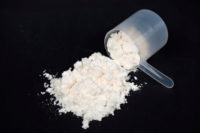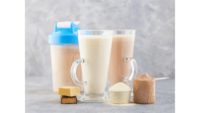Ragya Kapoor, senior scientist, plant-based and ingredient innovation for Ajinomoto Health & Nutrition North America Inc., shares some insights on enzyme-based binding solutions for protein.
What types of new product development for proteins are enzyme-based binding solutions ideal for?
Ragya Kapoor:
Enzyme-based binding solutions prove to be highly versatile for new product development, offering a range of benefits in texture and structure enhancement across various categories. Their application is particularly promising in the plant-based food industry, in the development of meat analogues such as burger patties and sausages, as well as in plant-based dairy products like cheese and yogurt. Enzymes offered by AHN catalyze the formation of iso-peptide bonds between proteins that induce the process of cross-linking (i.e. formation of covalent inter- or intramolecular bonds) further leading to improved binding properties and overall texture. Additionally, enzymes can play a role in creating low-fat products by using crosslinked proteins as effective fat substitutes in both plant-based and animal-based food products. Another notable mechanism involves certain proteins becoming viscous when treated with specific enzymes, acting as a binding glue ideal for holding different pieces of food products together. This particular mechanism is ideal for preparing larger pieces of restructured meat like steaks or fish fillets from their smaller pieces. These applications make AHN enzyme-based binding solutions an effective and unique tool for innovation in the food industry to develop high quality and value-added functional products.
What production efficiencies do enzyme-based binding solutions offer food processors?
Ragya Kapoor:
By enhancing protein binding, enzyme-based solutions contribute to improved texture and structural integrity. This results in reduced cooking losses during processing, ensuring better moisture retention and desired texture. The enzyme's ability to create a uniform protein network also enhances product consistency, vital for food processors to ensure each unit of product meets the desired specifications. Furthermore, improved binding properties can potentially allow for the elimination of certain hydrocolloids as well as use of lower cost protein sources or blends, optimizing raw material costs without compromising on the quality of the final product.
How can plant-based protein products benefit from enzyme-based binding solutions?
Ragya Kapoor:
Plant- based protein products are made using plant proteins which are typically globular, unlike animal proteins which can be globular, fibrous, or random coil. Therefore, a common issue with products made using plant proteins is that their texture is too soft and brittle rather than being firm and malleable like texture achieved from animal-based proteins. Enzyme-based solutions provide a promising strategy to tackle these textural issues by modifying plant proteins to enhance their functional characteristics. Through molecular crosslinks facilitated by certain enzymes, there's a positive impact on the physicochemical and structural characteristics of plant proteins. This modification extends to their ability to hold water, oil, gel strength, emulsification, viscosity, and elasticity. Moreover, certain enzyme solutions exhibit the unique functionality to induce gelation in many plant proteins, allowing for the development of mechanical and rheological properties that closely resemble their animal protein counterparts. In essence, AHN’s enzyme-based solutions can be used as a tool to tailor the texture of plant-based protein products, addressing textural challenges, and bringing them closer to the desired qualities of animal-based alternatives.
How can enzyme-based binding solutions enhance protein products’ flavor and improve shelf life?
Ragya Kapoor: Enzyme-based binding solutions can be utilized to enhance the flavor and extend the shelf life of protein products. By forming cross links between polypeptide chains, these enzymes create a gel structure that can effectively entrap and retain diverse flavor compounds present in the food matrix, thereby preserving the quality and taste of the product. This is especially valuable in preventing the migration and loss of volatile compounds, known to influence the sensory attributes and consumer acceptability of many protein-containing foods. In plant- protein based dairy products like yogurt, these solutions contribute to water retention within the gel structure, mitigating syneresis — a significant factor in shelf-life deterioration affecting consumer acceptability of yogurts. Similarly, in high protein bars and snacks category, enzyme-based solutions help retain moisture, preventing undesired hardening over the course of the product's shelf life and ultimately ensuring a more satisfying consumer experience.
What unique packaging requirements are needed for proteins created using enzyme-based binding solutions?
Ragya Kapoor: Products developed using AHN’s enzyme-based binding solutions typically do not necessitate unique packaging requirements. Moreover, the covalent nature of the cross-links established are largely resistant to the impacts of cooling, freezing and high temperatures. However, when considering the packaging of the product itself, standard best practices should be followed. Packaging material targeted towards preservation and protection of protein quality against external environmental conditions and contaminations should be kept in mind as well.




Report Abusive Comment